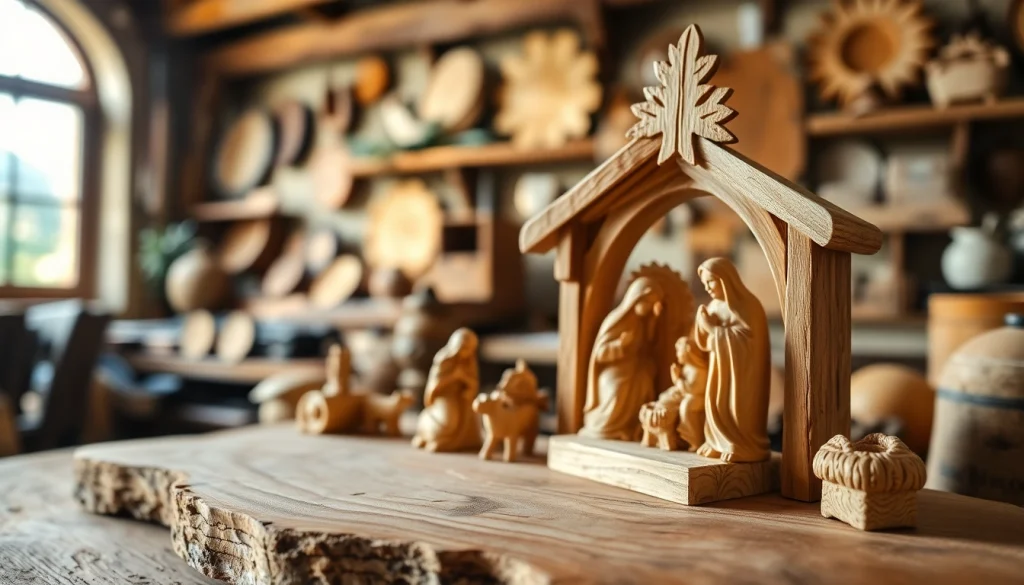The Heritage and Artistry Behind Olive Wood Carvings: A Journey Through Tradition

The History of Olive Wood Carvings
1. Origins of Olive Wood Carvings
The tradition of olive wood carving has its roots in the rich cultural and historical tapestry of the Holy Land. This craft can be traced back to ancient times, when artisans began to recognize the value of the olive tree, not only as a source of sustenance but also as a medium for art. The olive tree, revered for its resilience and longevity, has become synonymous with the region, particularly in areas such as Bethlehem and Jerusalem. Local craftspeople, many of whom are descendants of generations of artisans, have honed their skills to create intricate works that embody their spiritual beliefs and cultural heritage.
2. Cultural Significance in the Holy Land
Olive wood carvings carry profound cultural significance in the Holy Land, interwoven with the religious and social narratives of the region. The olive tree symbolizes peace, wisdom, and triumph, making it a perfect medium for the creation of religious artifacts. Beyond their artistic merit, these carvings serve as tangible connections to spirituality for many. Notably, many pieces are representations of biblical scenes, saints, and symbols, acting as reminders of faith for believers and collectors alike. As such, they hold a special place not just as decorative items, but as cherished components of ritual and devotion in Christian communities, attracting pilgrims and tourists seeking mementos of their religious journeys.
3. Famous Olive Wood Carving Styles
Over the centuries, a variety of distinctive carving styles have emerged from the Holy Land. Among the most recognized are traditional nativity scenes, crucifixes, and figures of saints. Each style captures the unique aspects of the artisans’ cultural influences. The Bethlehem nativity set, in particular, is renowned for its intricate detail, bringing to life the story of Jesus’ birth through beautifully carved figures and representations. Another notable style includes intricate decorative items that blend function with artistry, converting everyday objects into beautiful pieces of craft.
Understanding the Craftsmanship
1. Materials Used in Olive Wood Carvings
Olive wood is celebrated for its dense, beautiful grain and natural durability, making it particularly suitable for carving. The unique properties of olive wood allow artisans to achieve vivid finishes, varying from light to dark hues, depending on how they work with each piece. Every carving contains the unique patterns of the wood, ensuring no two pieces are identical. This individuality contributes significantly to the value and appeal of the art. Additionally, artisans take specific care in sourcing their materials, often using wood from older trees that have been pruned, ensuring sustainable practices within the industry.
2. Techniques Adopted by Artisans
Crafting olive wood carvings involves a meticulous process requiring immense skill and patience. Artisans typically employ a combination of hand tools and, in some cases, power tools for rough shaping. Traditional methods involve chiseling and whittling, where complex details are painstakingly created to capture expressions and textures. The shaping process is followed by a finishing touch that includes polishing and often incorporates natural oils to enhance the wood’s shine and protect it against environmental factors. Those who master these techniques are not only artists but also custodians of tradition, ensuring that ancient skills are passed down through generations.
3. Quality Factors in Olive Wood Products
When assessing the quality of olive wood carvings, several factors come into play. The craftsmanship is essential; pieces should display attention to detail without rough or unfinished edges. The wood selection is also crucial—premium carvings will come from mature trees with a rich grain and vibrant color. Moreover, the finishing process matters significantly, as quality products often showcase a glossy sheen and a smooth surface that highlights the natural beauty of the wood. Buyers should always look for signs of authenticity, ensuring their products are sourced sustainably and ethically.
Types of Olive Wood Carvings
1. Religious Figures and Symbols
Among the most sought-after olive wood carvings are religious figures and symbols, which often hold significant value for collectors and individuals of faith. Statues of saints, angels, and critical biblical scenes, such as the nativity, are frequent subjects. These pieces are often crafted with intricate detail, reflecting the religious narratives they represent. For many, these carvings are not merely ornamental; they serve as focal points for devotion, enhancing spiritual practice and personal reflection.
2. Decorative Items and Home Decor
Olive wood is not only used for religious objects; it is also crafted into a variety of decorative items and home décor pieces that blend aesthetics with functionality. Items such as bowls, serving platters, and candlesticks exemplify the versatility of olive wood carvings. Each piece’s unique grain and finish add warmth and character to interior spaces, making them desirable for those who appreciate artisan home products. Moreover, these decorative items often serve as talking points, highlighting the craftsmanship and stories behind their creation.
3. Custom-Made Olive Wood Art Pieces
For those looking to commemorate special occasions or create unique gifts, custom-made olive wood art pieces are an excellent option. Many artisans offer personalized services where clients can request specific designs or incorporate personal symbols or names into their carvings. This bespoke approach not only reflects the artisanal integrity of the creator but also elevates the emotional significance of the piece for the buyer. Whether it’s for weddings, anniversaries, or significant milestones, custom carvings are cherished and treasured, often becoming heirloom pieces over time.
Purchasing Olive Wood Carvings
1. Where to Buy Authentic Olive Wood Art
When searching for authentic olive wood carvings, it is crucial to purchase from reputable sources. Many artisans in the Holy Land have established direct online shops, allowing customers from around the world to access their creations. Additionally, visiting local craft fairs and artisan markets can provide opportunities to interact with makers directly. Online platforms specializing in Christian gifts or handmade products can also offer a wide array of options. For a curated selection, consider exploring olive wood carvings from recognized artisans and organizations.
2. What to Look for When Buying
When purchasing olive wood carvings, it’s vital to inspect the artistry and craftsmanship. Buyers should ensure that the pieces display intricate details, a smooth finish, and overall quality workmanship. Additionally, checking for provenance can enhance the buying experience, as knowing the story behind the carving can add value. It’s wise to verify that the wood is sourced ethically; reputable sellers will often provide documentation or certification that confirms sustainable practices.
3. Understanding Pricing and Value
The price of olive wood carvings can vary significantly based on several factors, including the complexity of the design, the size of the piece, and the artisan’s skill level. Simpler designs may start at more accessible price points, while intricate figures, especially those that are custom-made, can command higher prices. Understanding the market is beneficial when purchasing; looking at comparable pieces can provide insight into fair pricing and ensure that buyers get good value for their investment. Considering the artistry and cultural significance behind these works is essential when evaluating their worth.
Preservation and Care for Olive Wood Carvings
1. Cleaning and Maintenance Tips
To ensure the longevity of olive wood carvings, proper care and maintenance are crucial. Regular dusting with a soft, dry cloth effectively removes dust without damaging the wood’s surface. For deeper cleaning, a slightly damp cloth can be used, but it’s essential to avoid soaking the wood, as excessive moisture can lead to warping and cracking. Occasionally, applying a food-safe mineral oil or beeswax can rejuvenate the wood’s natural luster and protect against stains and moisture.
2. Best Practices for Longevity
To preserve the integrity of olive wood carvings, keep them away from direct sunlight and heat sources, as these can fade colors and dry out the wood. Additionally, it’s best to avoid exposure to harsh chemicals and cleaners, as these can affect the wood’s finish. For items such as bowls or serving platters, hand washing is recommended rather than using a dishwasher, which can impose extreme heat and moisture levels.
3. Common Mistakes to Avoid
One common mistake in caring for olive wood carvings is neglecting to regularly apply oil or wax, which can lead to the wood drying out and cracking over time. Moreover, failing to promptly wipe away spills can create potential stains that are difficult to remove later. Lastly, exposing olive wood to extreme temperatures—whether too hot or too cold—can cause it to warp or crack, so it’s essential to treat these artwork pieces with care and respect to ensure they remain as beautiful as the day they were crafted.




